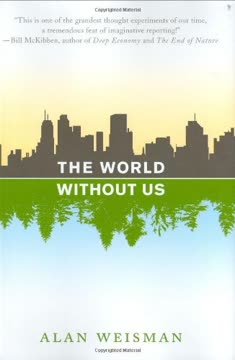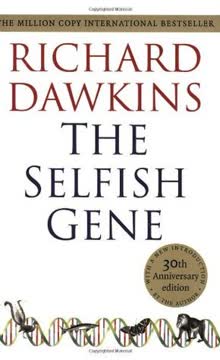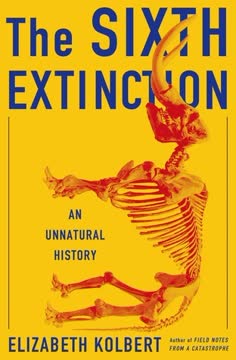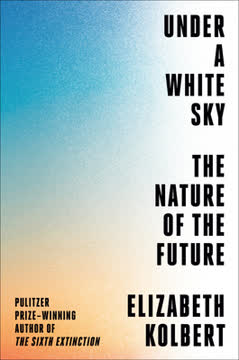Key Takeaways
1. The Sixth Extinction: Humans Are Causing Unprecedented Species Loss
"One weedy species has unwittingly achieved the ability to directly affect its own fate and that of most of the other species on this planet."
Unprecedented Species Loss. Humans are causing a mass extinction event that is fundamentally different from previous geological periods. Unlike past extinctions triggered by natural phenomena like asteroid impacts or volcanic eruptions, the current extinction is driven primarily by human activities.
Scale of Destruction. The current extinction rate is alarmingly high:
- Amphibians are the most endangered class of animals
- One-third of reef-building corals are at risk
- A quarter of mammals are heading toward extinction
- Approximately 40,000 times the background extinction rate is being observed
Comprehensive Impact. Human activities such as deforestation, climate change, pollution, and habitat fragmentation are creating a perfect storm of ecological disruption. No ecosystem is immune, from tropical rainforests to marine environments, demonstrating the truly global nature of this extinction event.
2. Extinction is Not New: Earth Has Experienced Mass Extinction Events Before
"Life on earth has often been disturbed by terrible events."
Historical Perspective. Earth has experienced five major mass extinction events over millions of years, each fundamentally reshaping life on the planet. These events were typically caused by dramatic environmental changes like asteroid impacts, massive volcanic eruptions, or extreme climate shifts.
Characteristics of Mass Extinctions:
- Eliminate a significant proportion of global biodiversity
- Occur rapidly in geological time
- Disrupt existing evolutionary pathways
- Lead to the emergence of new life forms in subsequent periods
Adaptation and Resilience. While life has repeatedly bounced back from these catastrophic events, each extinction fundamentally altered the planet's biological landscape, demonstrating both the fragility and remarkable resilience of life.
3. Climate Change and Ocean Acidification Are Driving Current Extinctions
"By burning through coal and oil deposits, humans are putting carbon back into the air that has been sequestered for tens—in most cases hundreds—of millions of years."
Rapid Environmental Transformation. Human-induced climate change is causing environmental shifts at an unprecedented rate, faster than most species can adapt. The speed of current changes is what makes this extinction event particularly dangerous.
Ocean Acidification Impacts:
- Oceans have absorbed 150 billion metric tons of CO2
- Surface water pH has dropped by 30% since 1800
- Calcifying organisms like corals are especially vulnerable
- Entire marine ecosystems are at risk of collapse
Ecosystem Disruption. Climate change doesn't just affect individual species but entire ecological networks, causing cascading effects that can rapidly destabilize complex environmental systems.
4. Habitat Fragmentation Threatens Biodiversity
"In the Anthropocene it's not clear that even such 'wildlands' really deserve to be called wild."
Landscape Transformation. Human activities are converting continuous ecosystems into fragmented, isolated patches, effectively creating "islands" that disrupt natural migration and interaction patterns of species.
Fragmentation Consequences:
- Reduces genetic diversity
- Increases species vulnerability
- Disrupts ecological interactions
- Makes species more susceptible to local extinction
Complex Ecological Dynamics. Fragmentation doesn't just reduce habitat size but fundamentally alters ecosystem functioning, making it harder for species to survive and adapt.
5. Invasive Species Disrupt Ecological Balances
"We are reassembling the world into one enormous supercontinent."
Global Biological Mixing. Human activities are transporting species across continents at an unprecedented rate, breaking down millennia-old geographical barriers and creating new, unpredictable ecological interactions.
Invasive Species Impacts:
- Displace native species
- Alter ecosystem dynamics
- Can cause rapid, catastrophic changes
- Often lack natural predators in new environments
Unintended Consequences. The movement of species is creating a "New Pangaea" where ecological communities are being fundamentally restructured, often with devastating results for native species.
6. Humans Have Been Driving Species to Extinction Since Prehistoric Times
"Humans are capable of driving virtually any large mammal species extinct."
Long History of Extinction. Human-driven extinctions didn't begin with industrialization but date back to prehistoric times, with megafauna disappearing shortly after human arrival in new regions.
Early Human Impact:
- Drove many large mammals to extinction
- Transformed landscapes through hunting and land use
- Disrupted ecological balance even with primitive technologies
Ongoing Pattern. The current extinction event is an acceleration of a long-standing pattern of human-driven ecological transformation.
7. Technological Solutions Alone Cannot Solve the Extinction Crisis
"We might include among them—for curiosity's sake and to keep our options open—a species or two of large naked rodent."
Limitations of Conservation Technology. While technologies like genetic preservation and species conservation efforts are important, they cannot fully compensate for ongoing ecological destruction.
Preservation Strategies:
- Frozen zoos storing genetic material
- Captive breeding programs
- Advanced reproductive technologies
Fundamental Transformation Needed. Technological solutions must be accompanied by systemic changes in human behavior and environmental interaction.
8. The Anthropocene Marks a New Geological Epoch of Human Impact
"We have already left a record that is now indelible."
Unprecedented Geological Influence. Humans have become a geological force, fundamentally altering planetary systems in ways that will be detectable millions of years in the future.
Anthropocene Characteristics:
- Rapid environmental transformation
- Global-scale biological redistribution
- Significant changes to atmospheric and oceanic chemistry
- Unprecedented extinction rates
Long-Term Implications. The current epoch represents a radical departure from previous geological periods, with human activity becoming the primary driver of planetary change.
9. Genetic Diversity and Ecosystem Complexity Are Rapidly Declining
"If we continue the way we are, without making dramatic changes to our carbon emissions immediately, I think we're looking at a situation where, in the future, what we've got at best is remnant patches of corals."
Erosion of Biological Complexity. The current extinction event is not just about losing individual species but about fundamentally reducing the planet's genetic and ecological diversity.
Diversity Loss Mechanisms:
- Habitat destruction
- Climate change
- Invasive species
- Pollution
- Overexploitation
Systemic Vulnerability. Reduced biodiversity makes ecosystems less resilient and more susceptible to further disruption.
10. Our Actions Today Will Determine the Future of Life on Earth
"Right now, in the amazing moment that to us counts as the present, we are deciding, without quite meaning to, which evolutionary pathways will remain open and which will forever be closed."
Critical Moment in Evolutionary History. Humans are currently making decisions that will have profound, long-lasting impacts on the planet's biological future.
Potential Outcomes:
- Continued mass extinction
- Ecosystem collapse
- Potential human vulnerability
- Opportunity for transformative conservation
Call to Action. The choices we make in the coming decades will significantly influence the trajectory of life on Earth, making individual and collective action critically important.
Last updated:
FAQ
What's The Sixth Extinction: An Unnatural History about?
- Focus on Extinction Events: The book examines the current mass extinction event, known as the Sixth Extinction, primarily driven by human activities. It compares this event to the five major extinction events in Earth's history.
- Human Impact: Elizabeth Kolbert highlights how human actions, such as habitat destruction and climate change, are accelerating extinction rates, altering ecosystems globally.
- Interconnectedness of Life: The narrative explores the complex relationships within ecosystems, showing how the loss of one species can affect others, using case studies like the Panamanian golden frog.
Why should I read The Sixth Extinction?
- Timely and Relevant: The book addresses pressing environmental issues, making it essential for those concerned about biodiversity and climate change.
- Engaging Narrative: Kolbert combines scientific research with personal storytelling, making complex topics accessible and engaging.
- Critical Insights: It offers insights into the consequences of human actions on the environment, encouraging reflection and action for conservation.
What are the key takeaways of The Sixth Extinction?
- Mass Extinction is Happening Now: The book argues that human activities are causing a mass extinction event, with extinction rates much higher than historical norms.
- Historical Context: Kolbert provides a historical overview of past extinction events, helping readers understand the current crisis's gravity.
- Hope for Change: Despite the grim outlook, the book highlights conservation efforts and the importance of awareness and action.
What are the best quotes from The Sixth Extinction and what do they mean?
- "We are losing all these amphibians before we even know that they exist.": Highlights the urgency of biodiversity loss and the need for conservation.
- "The history of life consists of long periods of boredom interrupted occasionally by panic.": Reflects the cyclical nature of extinction and evolution.
- "We have already left a record that is now indelible.": Emphasizes the lasting impact of human actions on geological history.
What is the significance of the term "Anthropocene" in The Sixth Extinction?
- Human-Dominated Era: The Anthropocene is a proposed epoch marked by significant human impact on Earth's geology and ecosystems.
- Geological Record: Kolbert explains that the Anthropocene will leave a distinct mark, similar to past extinction events.
- Call to Action: The term urges readers to recognize their role in shaping the planet's future and the need for environmental stewardship.
How does The Sixth Extinction address the concept of extinction rates?
- Current Extinction Rates: Kolbert presents alarming statistics showing that current extinction rates are significantly higher than historical rates.
- Factors Contributing to Extinction: The book details factors like habitat destruction and climate change as drivers of the current crisis.
- Implications for Biodiversity: Rising extinction rates disrupt ecosystems, leading to further species loss and ecological decline.
How does The Sixth Extinction connect past and present extinction events?
- Historical Patterns: Kolbert draws parallels between past events, like the end-Cretaceous extinction, and the current crisis.
- Lessons Learned: Understanding past extinctions can inform current conservation efforts and strategies.
- Cyclical Nature of Extinction: While life has recovered from past events, the current rate of extinction poses a unique threat.
What role do scientists play in addressing extinction, according to The Sixth Extinction?
- Research and Conservation: Scientists work to understand and mitigate extinction impacts, informing conservation strategies.
- Public Awareness: Effective communication of scientific findings is crucial for mobilizing action and support for conservation.
- Collaboration and Innovation: Collaboration among scientists, policymakers, and the public is essential for preserving endangered species.
How does The Sixth Extinction illustrate the interconnectedness of species?
- Ecosystem Dynamics: The loss of one species can have cascading effects on entire ecosystems, disrupting food webs and relationships.
- Case Studies: Examples like the decline of amphibians show how interconnected species are and the impact of their loss.
- Human Impact: Human activities disrupt these relationships, leading to rapid biodiversity declines.
How does The Sixth Extinction address climate change?
- Climate Change as a Driver: Kolbert highlights climate change as a primary factor in the current extinction crisis.
- Examples from Ecosystems: Rising temperatures and ocean acidification threaten species' habitats and survival.
- Call for Action: Immediate action is needed to combat climate change and protect biodiversity.
What role do invasive species play in extinction, according to The Sixth Extinction?
- Threat to Native Species: Invasive species outcompete natives for resources, leading to biodiversity declines.
- Examples of Invasives: Species like the brown tree snake illustrate the consequences of human actions on ecosystems.
- Management Challenges: Prevention and control measures are crucial for protecting native biodiversity.
How does The Sixth Extinction explore the concept of biotic attrition?
- Definition of Biotic Attrition: Describes the gradual loss of species due to environmental changes and human impact.
- Cumulative Effects: Small changes can lead to significant biodiversity declines, often overlooked in extinction discussions.
- Long-term Consequences: Biotic attrition reshapes ecosystems and evolutionary trajectories, highlighting the need to address biodiversity loss.
Review Summary
The Sixth Extinction is widely praised as an engaging and informative exploration of mass extinctions, focusing on the current human-caused crisis. Kolbert's writing style, combining scientific research with personal experiences, makes complex topics accessible. The book covers historical extinctions, current threats to biodiversity, and human impact on the environment. Many readers find it eye-opening and depressing, emphasizing the urgency of environmental protection. Some critics note familiar content or occasional dryness, but most consider it a crucial read for understanding our planet's ecological challenges.
Similar Books










Download PDF
Download EPUB
.epub digital book format is ideal for reading ebooks on phones, tablets, and e-readers.





